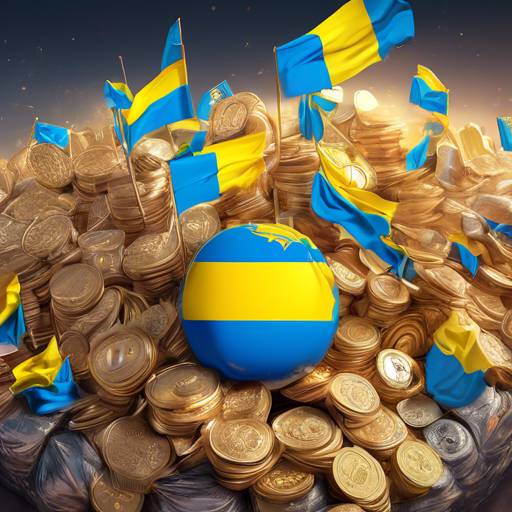Using Crypto Donations for Humanitarian Aid in Ukraine: Challenges and Opportunities
The ongoing war between Russia and Ukraine has led to a dire humanitarian crisis, with thousands of lives at stake. While there has been significant international support in the form of donations, the question arises as to why cryptocurrencies are not being widely used as a means of payment for critical aid during this time. This article explores the rise of crypto donations in Ukraine, the challenges faced in converting them into fiat currency, and the need for clear regulatory frameworks to facilitate crypto payments.
The Rise of Crypto Donations
In February 2022, Ukraine’s Minister of Digital Transformations announced that the country officially accepts donations in Ethereum (ETH), Bitcoin (BTC), and Tether (USDT). This crowdfunding appeal resulted in over $13 million raised within the first few days. Over a period of two years, Ukraine received more than $225 million in crypto donations from supporters worldwide. The majority of these donations were made in ETH, followed by USDT, BTC, and BUSD.
- NFT donations also saw a significant spike, with a CryptoPunk NFT worth $200,000 being donated to the Ukrainian government’s ETH account. The Ukrainian flag was also auctioned off as an NFT for $6.5 million.
Crypto Donations vs. Traditional Financial Instruments
Despite the success of crypto donations, there are challenges when it comes to converting them into fiat currency for immediate use. Many smaller funds and volunteers who raised financial aid also accepted cryptocurrencies but needed to convert them into fiat for future purchases. However, restrictions imposed by Ukrainian authorities on P2P and A2C operations for financial companies made it difficult for crypto users to operate digital currencies.
- The lack of clear regulations regarding the use of cryptocurrencies as a means of payment further hinders their adoption in times of war. In Ukraine, using digital currencies for goods or services is officially forbidden.
The Need for a Clear Regulatory Framework
Adopting crypto payments during times of war could eliminate third-party intermediaries and enable faster circulation of funds for critical supplies. However, without a clear regulatory framework, this is not possible. While the Ukrainian government attempted to develop regulations during the early stages of the war, the draft law on virtual assets was ultimately rejected in 2023.
- In April 2023, there was a second attempt to create a regulatory framework for the Ukrainian crypto market, focusing primarily on taxation. However, the government’s priority seems to be ensuring tax compliance rather than facilitating the use of crypto donations.
The Impact of Imposed Restrictions
The restrictions imposed by Ukrainian authorities not only affect the use of crypto donations within the country but also hinder international support. The lack of convenient options for converting raised funds into fiat currency delays the timely delivery of aid and reduces transparency for supporters who want to ensure their donations are being used as intended.
- Furthermore, the ongoing withdrawal issues on crypto exchanges in Ukraine add another layer of complexity to the situation. Withdrawals to bank accounts are currently unavailable, making it difficult for smaller funds and individual volunteers to operate with digital currencies.
Hot Take: The Urgent Need for Crypto Payments in Humanitarian Aid
The war in Ukraine has highlighted both the potential and challenges of using crypto donations for humanitarian aid. The rise in crypto donations demonstrates their effectiveness in international fundraising due to their decentralized nature and resistance to censorship. However, without clear regulatory frameworks and convenient conversion options, their full potential remains untapped.
By adopting crypto payments, humanitarian organizations can eliminate intermediaries, ensure faster circulation of funds, and provide greater transparency to supporters. This would enable a more efficient response to critical situations and help save more lives.
The Ukrainian government, as well as international organizations, must prioritize the development of clear regulations that allow for the use of cryptocurrencies as a means of payment. Additionally, crypto exchanges need to address withdrawal issues and provide convenient options for converting crypto into fiat currency.
It is crucial for the crypto industry to bridge the gap with traditional finance systems and regain trust through regulatory compliance. The upcoming MiCA regulation in the EU can serve as a model for creating a regulatory framework that ensures protection and smoother service provision for merchants across the region.
In conclusion, while crypto donations have played a significant role in supporting Ukraine during the war, there are still challenges that need to be addressed. By overcoming these challenges and embracing crypto payments, we can enhance the speed, transparency, and effectiveness of humanitarian aid efforts.
Noah Rypton stands as an enigmatic fusion of crypto analyst, relentless researcher, and editorial virtuoso, illuminating the uncharted corridors of cryptocurrency. His odyssey through the crypto realms reveals intricate tapestries of digital assets, resonating harmoniously with seekers of all stripes. Noah’s ability to unfurl the labyrinthine nuances of crypto intricacies is elegantly interwoven with his editorial finesse, transmuting complexity into an engaging symphony of comprehension.

